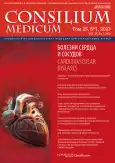Роль стресса и нарушений сна в развитии сердечно-сосудистых осложнений у пациентов с артериальной гипертензией: что важно знать интернисту?
- Авторы: Ионин В.А.1
-
Учреждения:
- ФГБОУ ВО «Первый Санкт-Петербургский государственный медицинский университет им. акад. И.П. Павлова» Минздрава России
- Выпуск: Том 25, № 1 (2023): Болезни сердца и сосудов
- Страницы: 15-19
- Раздел: Статьи
- URL: https://journals.rcsi.science/2075-1753/article/view/131631
- DOI: https://doi.org/10.26442/20751753.2023.1.202133
- ID: 131631
Цитировать
Полный текст
Аннотация
В данной публикации обсуждаются механизмы, лежащие в основе развития артериальной гипертензии на фоне стресса, рассмотрены актуальные проблемы контроля артериального давления у пациентов со стресс-индуцированными нарушениями сна, клинические особенности пациентов с гиперсимпатикотонией как главным механизмом развития артериальной гипертензии и вариабельности артериального давления у пациентов с коморбидной патологией, алгоритм диагностики, а также представлены современные рекомендации в стратегии выбора оптимальной антигипертензивной терапии с возможностью персонализированного выбора в различных клинических ситуациях.
Ключевые слова
Полный текст
Открыть статью на сайте журналаОб авторах
Валерий Александрович Ионин
ФГБОУ ВО «Первый Санкт-Петербургский государственный медицинский университет им. акад. И.П. Павлова» Минздрава России
Автор, ответственный за переписку.
Email: ionin.v.a@gmail.com
ORCID iD: 0000-0001-7293-1144
канд. мед. наук, доц. каф. факультетской терапии с курсом эндокринологии, кардиологии с клиникой им. акад. Г.Ф. Ланга, ст. науч. сотр.
Россия, Санкт-ПетербургСписок литературы
- Kotseva K, de Backer G, de Bacquer D, et al. Lifestyle and impact on cardiovascular risk factor control in coronary patients across 27 countries: Results from the European Society of Cardiology ESC-EORP EUROASPIRE V registry. Eur J Prev Cardiol. 2019;26:824-35.
- Ezzati M, Lopez AD, Rodgers A, et al. Selected major risk factors and global and regional burden of disease. Lancet. 2002;360:1347-60.
- Lewington S, Clarke R, Qizilbash N, et al. Age-specific relevance of usual blood pressure to vascular mortality: A meta-analysis of individual data for one million adults in 61 prospective studies. Lancet. 2002;360:1903-13.
- Karmali KN, Persell SD, Perel P, et al. Risk scoring for the primary prevention of cardiovascular disease. Cochrane Database Syst Rev. 2017;3. doi: 10.1002/14651858.CD006887.PUB4
- Kivimäki M, Steptoe A. Effects of stress on the development and progression of cardiovascular disease. Nat Rev Cardiol. 2018;15:215-29.
- Rozanski A. Behavioral cardiology: current advances and future directions. J Am Coll Cardiol. 2014;64:100-10.
- Albus C, Waller C, Fritzsche K, et al. Significance of psychosocial factors in cardiology: update. 2018: Position paper of the German Cardiac Society. Clin Res Cardiol. 2019;108:1175-96.
- Schultz WM, Kelli HM, Lisko JC, et al. Socioeconomic Status and Cardiovascular Outcomes: Challenges and Interventions. Circulation. 2018;137:2166-78.
- Visseren FLJ, Mach F, Smulders YM, et al. 2021 ESC Guidelines on cardiovascular disease prevention in clinical practice. Eur Heart J. 2021;42:3227-337.
- Julius S, Palatini P, Kjeldsen SE, et al. Usefulness of heart rate to predict cardiac events in treated patients with high-risk systemic hypertension. Am J Cardiol. 2012;109:685-92.
- Williams B, Mancia G, Spiering W, et al. 2018 ESC/ESH Guidelines for themanagement of arterial hypertension. Eur Heart J. 2018;39:3021-104.
- Seravalle G, Facchetti R, Cappellini C, et al. Elevated heart rate as sympathetic biomarker in human obesity. Nutr Metab Cardiovasc Dis. 2022;32. doi: 10.1016/J.NUMECD.2022.07.011
- Fatani BZ, Al-Yahyawi H, Raggam AA, et al. Perceived stress and willingness to quit smoking among patients with depressive and anxiety disorders seeking treatment. Health Sci Rep. 2022;5. doi: 10.1002/HSR2.503
- Leone A. Smoking and hypertension: independent or additive effects to determining vascular damage? Curr Vasc Pharmacol. 2011;9:585-93.
- Hering D, Kucharska W, Kara T, et al. Smoking is associated with chronic sympathetic activation in hypertension. Blood Press. 2010;19:152-5.
- Prichard BNC. The use of moxonidine in the treatment of hypertension. J Hypertens. 1997;15. doi: 10.1097/00004872-199715011-00007
- Karlafti EF, Hatzitolios AI, Karlaftis AF, et al. Effects of moxonidine on sympathetic nervous system activity: An update on metabolism, cardio, and other target-organ protection. J Pharm Bioallied Sci. 2013;5:253-6.
- Бойцов С.А., Баланова Ю.А., Шальнова С.А., и др. Артериальная гипертония среди лиц 25–64 лет: распространенность, осведомленность, лечение и контроль. По материалам исследования ЭССЕ. Кардиоваскулярная терапия и профилактика. 2014;13(4):4-14 [Boytsov SA, Balanova YuA, Shalnova SA, et al. Arterial hypertension among individuals of 25–64 years old: prevalence, awareness, treatment and control. By the data from ECCD. Cardiovascular Therapy and Prevention. 2014;13(4):4-14 (in Russian)].
- Sanjuliani AF, de Abreu VG, Francischetti EA. Selective imidazoline agonist moxonidine in obese hypertensive patients. Int J Clin Pract. 2006;60:621-9.
- Karlafti EF, Hatzitolios AI, Karlaftis AF, et al. Effects of moxonidine on sympathetic nervous system activity: An update on metabolism, cardio, and other target-organ protection. J Pharm Bioallied Sci. 2013;5:253-6.
- Li M, Zhang XW, Hou WS, Tang ZY. Insomnia and risk of cardiovascular disease: a meta-analysis of cohort studies. Int J Cardiol. 2014;176:1044-7.
- Cappuccio FP, D’Elia L, Strazzullo P, Miller MA. Sleep duration and all-cause mortality: a systematic review and meta-analysis of prospective studies. Sleep. 2010;33:585-92.
- Magee CA, Kritharides L, Attia J, et al. Short and long sleep duration are associated with prevalent cardiovascular disease in Australian adults. J Sleep Res. 2012;21:441-7.
- Lo K, Woo B, Wong M, Tam W. Subjective sleep quality, blood pressure, and hypertension: a meta-analysis. J Clin Hypertens. 2018;20:592.
- Mansoor GA, White WB, McCabe EJ, Giacco S. The relationship of electronically monitored physical activity to blood pressure, heart rate, and the circadian blood pressure profile. Am J Hypertens. 2000;13:262-7.
- Johns MW. A new method for measuring daytime sleepiness: the Epworth sleepiness scale. Sleep. 1991;14:540-5.
- Hsieh CG, Martin JL. Short Sleep, Insomnia, and Cardiovascular Disease. Curr Sleep Med Rep. 2019;5:234.
- Ernsberger P, Graves ME, Graff LM, et al. I1-imidazoline receptors. Definition, characterization, distribution, and transmembrane signaling. Ann N Y Acad Sci. 1995;763:22-42.
- Переверзев А. Оригинальные и воспроизведенные лекарственные средства: действительно ли они сопоставимы? Акцент на моксонидин. РМЖ. 2021;29(9):6-10 [Pereverzev AP. Original and reproduced medicinal products: are they comparable? Emphasis on moxonidine. RMJ. 2021;9:6-10 (in Russian)].
Дополнительные файлы






